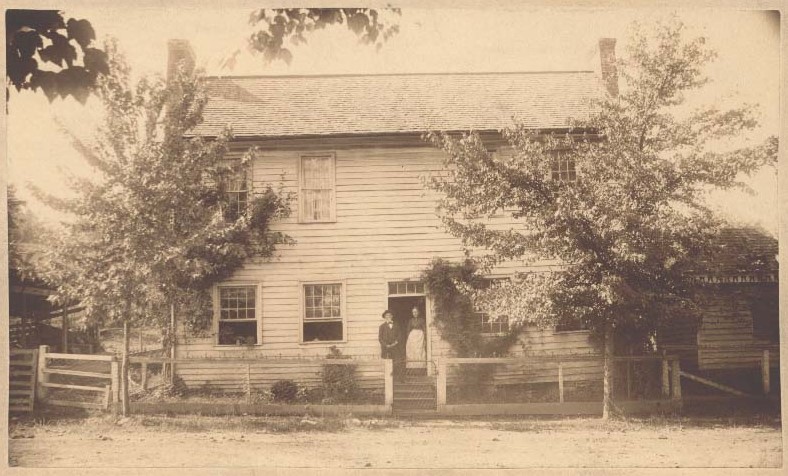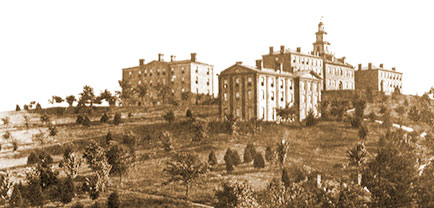|
Fort Southwest Point
Fort Southwest Point was a federal frontier outpost at what is now Kingston, Tennessee, in the Southeastern United States. Constructed in 1797 and garrisoned by federal soldiers until 1811, the fort served as a major point of interaction between the Cherokee and the United States government as well as a way station for early migrants travelling between Knoxville and Nashville. Although there are no records and few contemporary descriptions pertaining to the fort's design and structure, archaeological excavations conducted in the 1970s and 1980s have determined the fort's layout. Based on these findings, the City of Kingston and the Tennessee Division of Archaeology have reconstructed part of the fort. The site is managed by the City of Kingston. Geographical setting The Fort Southwest Point site is situated on a hill overlooking the confluence of the Tennessee River and the Clinch River. This confluence is now part of the Watts Bar Lake impoundment of the Tennessee River, cre ... [...More Info...] [...Related Items...] OR: [Wikipedia] [Google] [Baidu] |
Kingston, Tennessee
Kingston is a city in and the county seat of Roane County, Tennessee, United States. This city is thirty-six miles southwest of Knoxville. It had a population of 5,934 at the 2010 United States census, and is included in the Harriman Micropolitan Statistical Area. Kingston is adjacent to Watts Bar Lake. History Kingston has its roots in Fort Southwest Point, which was built just south of present-day Kingston in 1792. At the time, Southwest Point was on the fringe of the legal settlement area for Euro-Americans. A Cherokee village, headed by Chief Tollunteeskee, was situated just across the river, at what is now Rockwood. In 1805, Colonel Return J. Meigs, who operated out of Southwest Point, was appointed Cherokee Agent, effectively moving the agency from the Tellico Blockhouse to Southwest Point. The city of Kingston was established on October 23, 1799, as part of an effort to partition Knox County (the initial effort to form a separate county failed, but succeeded two ... [...More Info...] [...Related Items...] OR: [Wikipedia] [Google] [Baidu] |
Cherokee–American Wars
The Cherokee–American wars, also known as the Chickamauga Wars, were a series of raids, campaigns, ambushes, minor skirmishes, and several full-scale frontier battles in the Old Southwest from 1776 to 1794 between the Cherokee and American settlers on the frontier. Most of the events took place in the Upper South region. While the fighting stretched across the entire period, there were extended periods with little or no action. The Cherokee leader Dragging Canoe, whom some historians call "the Savage Napoleon", and his warriors, and other Cherokee fought alongside and together with warriors from several other tribes, most often the Muscogee in the Old Southwest and the Shawnee in the Old Northwest. During the Revolutionary War, they also fought alongside British troops, Loyalist militia, and the King's Carolina Rangers against the rebel colonists, hoping to expel them from their territory. Open warfare broke out in the summer of 1776 in the Overmountain settlements of the W ... [...More Info...] [...Related Items...] OR: [Wikipedia] [Google] [Baidu] |
Radiocarbon Dating
Radiocarbon dating (also referred to as carbon dating or carbon-14 dating) is a method for determining the age of an object containing organic material by using the properties of radiocarbon, a radioactive isotope of carbon. The method was developed in the late 1940s at the University of Chicago by Willard Libby. It is based on the fact that radiocarbon () is constantly being created in the Earth's atmosphere by the interaction of cosmic rays with atmospheric nitrogen. The resulting combines with atmospheric oxygen to form radioactive carbon dioxide, which is incorporated into plants by photosynthesis; animals then acquire by eating the plants. When the animal or plant dies, it stops exchanging carbon with its environment, and thereafter the amount of it contains begins to decrease as the undergoes radioactive decay. Measuring the amount of in a sample from a dead plant or animal, such as a piece of wood or a fragment of bone, provides information that can be used to calc ... [...More Info...] [...Related Items...] OR: [Wikipedia] [Google] [Baidu] |
Storage Pit (archaeology)
Storage pits are underground cists that were used historically to protect the seeds for the following year's crops, and to stop surplus food from being eaten by insects and rodents. These underground pits were sometimes lined and covered, for example with slabs of stone and bark and tightly sealed with adobe.''Man in the San Juan Valley.'' Aztec Ruins National Monument, National Park Service. January 13, 2001. Retrieved 10-18-2011. Examples in , |
University Of Tennessee
The University of Tennessee (officially The University of Tennessee, Knoxville; or UT Knoxville; UTK; or UT) is a public land-grant research university in Knoxville, Tennessee. Founded in 1794, two years before Tennessee became the 16th state, it is the flagship campus of the University of Tennessee system, with ten undergraduate colleges and eleven graduate colleges. It hosts more than 30,000 students from all 50 states and more than 100 foreign countries. It is classified among "R1: Doctoral Universities – Very high research activity". UT's ties to nearby Oak Ridge National Laboratory, established under UT President Andrew Holt and continued under the UT–Battelle partnership, allow for considerable research opportunities for faculty and students. Also affiliated with the university are the Howard H. Baker Jr. Center for Public Policy, the University of Tennessee Anthropological Research Facility, and the University of Tennessee Arboretum, which occupies of nearby Oak R ... [...More Info...] [...Related Items...] OR: [Wikipedia] [Google] [Baidu] |
Tennessee Valley Authority
The Tennessee Valley Authority (TVA) is a federally owned electric utility corporation in the United States. TVA's service area covers all of Tennessee, portions of Alabama, Mississippi, and Kentucky, and small areas of Georgia, North Carolina, and Virginia. While owned by the federal government, TVA receives no taxpayer funding and operates similarly to a private for-profit company. It is headquartered in Knoxville, Tennessee, and is the sixth largest power supplier and largest public utility in the country. The TVA was created by Congress in 1933 as part of President Franklin D. Roosevelt's New Deal. Its initial purpose was to provide navigation, flood control, electricity generation, fertilizer manufacturing, regional planning, and economic development to the Tennessee Valley, a region that had suffered from lack of infrastructure and poverty during the Great Depression, relative to the rest of the nation. TVA was envisioned both as a power supplier and a regional economi ... [...More Info...] [...Related Items...] OR: [Wikipedia] [Google] [Baidu] |
Hiwassee River
The Hiwassee River has its headwaters on the north slope of Rocky Mountain in Towns County in the northern area of the State of Georgia. It flows northward into North Carolina before turning westward into Tennessee, flowing into the Tennessee River a few miles west of what is now State Route 58 in Meigs County, Tennessee. The river is about long. Hydrography The river is dammed by the Tennessee Valley Authority (TVA) in four locations, all in Western North Carolina: Chatuge Dam, Mission Dam (not owned by TVA), Hiwassee Dam, and Apalachia Dam. Water is diverted from the stream bed at Apalachia Dam and sent through a pipeline, which is tunneled through the mountains for eight miles (13 km); then it flows through the Apalachia Powerhouse to generate electricity. The stretch of the river that flows between Apalachia Dam and Apalachia Powerhouse features reduced flow. The John Muir Trail in Tennessee's Cherokee National Forest goes along this part of the river. The stretch ... [...More Info...] [...Related Items...] OR: [Wikipedia] [Google] [Baidu] |
Return J
Return may refer to: In business, economics, and finance * Return on investment (ROI), the financial gain after an expense. * Rate of return, the financial term for the profit or loss derived from an investment * Tax return, a blank document or template supplied by a government for use in the reporting of tax information * Product return, the process of bringing back merchandise to a retailer for a refund or exchange * Returns (economics), the benefit distributed to the owner of a factor of production * Abnormal return, denoting the difference in behaviour between one stock and the overall stock market * Taxes, where tax returns are forms submitted to taxation authorities In technology * Return (architecture), the receding edge of a flat face * Carriage return, a key on an alphanumeric keyboard commonly equated with the "enter" key * Return statement, a computer programming statement that ends a subroutine and resumes execution where the subroutine was called * Return code, a met ... [...More Info...] [...Related Items...] OR: [Wikipedia] [Google] [Baidu] |
Dragoon
Dragoons were originally a class of mounted infantry, who used horses for mobility, but dismounted to fight on foot. From the early 17th century onward, dragoons were increasingly also employed as conventional cavalry and trained for combat with swords and firearms from horseback. While their use goes back to the late 16th century, dragoon regiments were established in most European armies during the 17th and early 18th centuries; they provided greater mobility than regular infantry but were far less expensive than cavalry. The name reputedly derives from a type of firearm, called a ''dragon'', which was a handgun version of a blunderbuss, carried by dragoons of the French Army. The title has been retained in modern times by a number of armoured or ceremonial mounted regiments. Origins and name The establishment of dragoons evolved from the practice of sometimes transporting infantry by horse when speed of movement was needed. In 1552, Alexander Farnese, Duke of Parma ... [...More Info...] [...Related Items...] OR: [Wikipedia] [Google] [Baidu] |



